Listen to this article:
Key Takeaway
Heart-opening yoga poses, or backbends, not only enhance physical flexibility and posture but also promote emotional healing and energetic balance by stimulating the heart chakra.
Did you know certain yoga poses can help you feel more connected to yourself, more compassionate towards others, and even aid in emotional healing?
Backbends, also known as heart openers, are POWERFUL yoga postures that work on a physical, mental, emotional, and energetic level.
So what are the best open heart yoga poses, and how can you practice them safely and effectively?
In this guide, I share the top 10 backbends in yoga and my top 3 tips for mastering these beautiful-looking asanas.
Contents
- 1 The Link Between Open Heart Yoga Poses And The Heart Chakra
- 2 Physical Benefits Of Heart-Opening Yoga Poses
- 3 Top 10 Heart-Opening Yoga Poses
- 4 How To Stay Safe when Practicing Heart-Opening Yoga Poses
- 5 The Emotional and Physical Connection of Heart Openers
- 6 The Importance of Breathing in Heart-Opening Yoga
- 7 Final Thoughts On Heart-Opening Yoga Postures
The Link Between Open Heart Yoga Poses And The Heart Chakra
According to yogic philosophy, the heart chakra is the fourth energy center of the chakra system. This chakra relates to matters of the heart and determines how well we can give and receive love, as well as feel empathy, compassion, gratitude, and joy.
The heart chakra is located in the center of the chest. It is believed that yoga poses that stretch and open the physical heart center also stimulate and open the heart chakra. Thus, heart-opening yoga poses can free up stagnated or blocked energy here, allowing us to experience a deeper feeling and expression of love.
Another key benefit of an open heart chakra is emotional healing. Known as the emotional heart, this energetic center allows us to grieve and heal from past hurts and, thus, move on from them.
Physical Benefits Of Heart-Opening Yoga Poses
Aside from the many emotional benefits, heart-opening postures are highly beneficial for the physical body. Backbends typically:
- Strengthen the spine and back muscles.
- Increase spinal flexibility and mobility.
- Open the lungs and improve the functioning of the respiratory system.
- Promote good posture.
- Help to relieve backache and other tension and pain in this area, including sciatica.
- Stretch the abdominal muscles to improve digestion.
Top 10 Heart-Opening Yoga Poses
Here is a mix of gentle and deep backbends you can try in your next yoga practice. Be sure to check out the tips at the end of this article for attempting them, though!
Cobra Pose
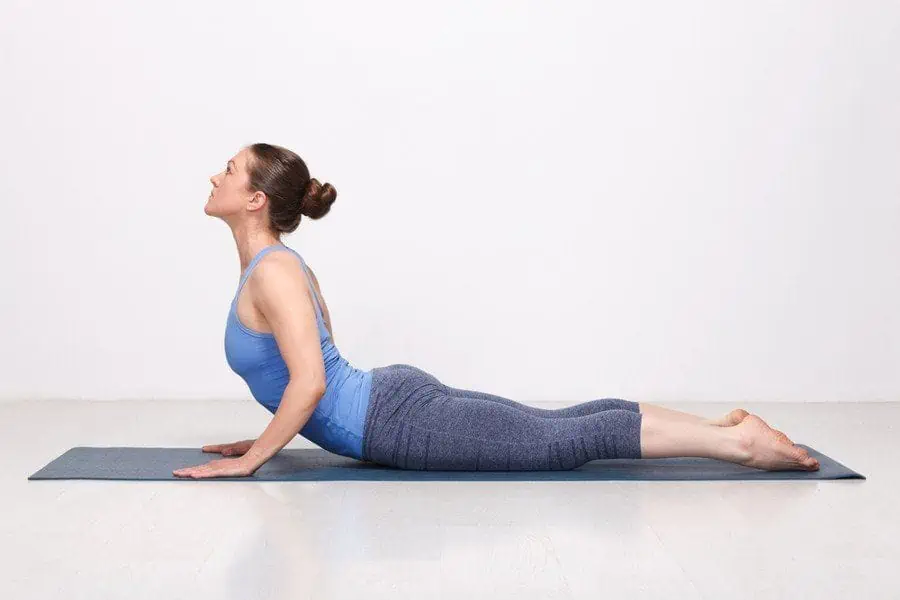
Cobra pose is one of the most commonly practiced heart openers, as it is included in the modified sun salutations. It is a gentle backbend that strengthens the lower back while opening the chest, shoulder blades, neck, and collar bones.
Enter cobra pose from a prone position with your hands under your shoulders, engage your glutes, and press your hips down as you lift your chest upward. Avoid pushing into your hands to lift. Instead, stay light on your hands and use your lower back muscles to lift the chest.
Upward Facing Dog
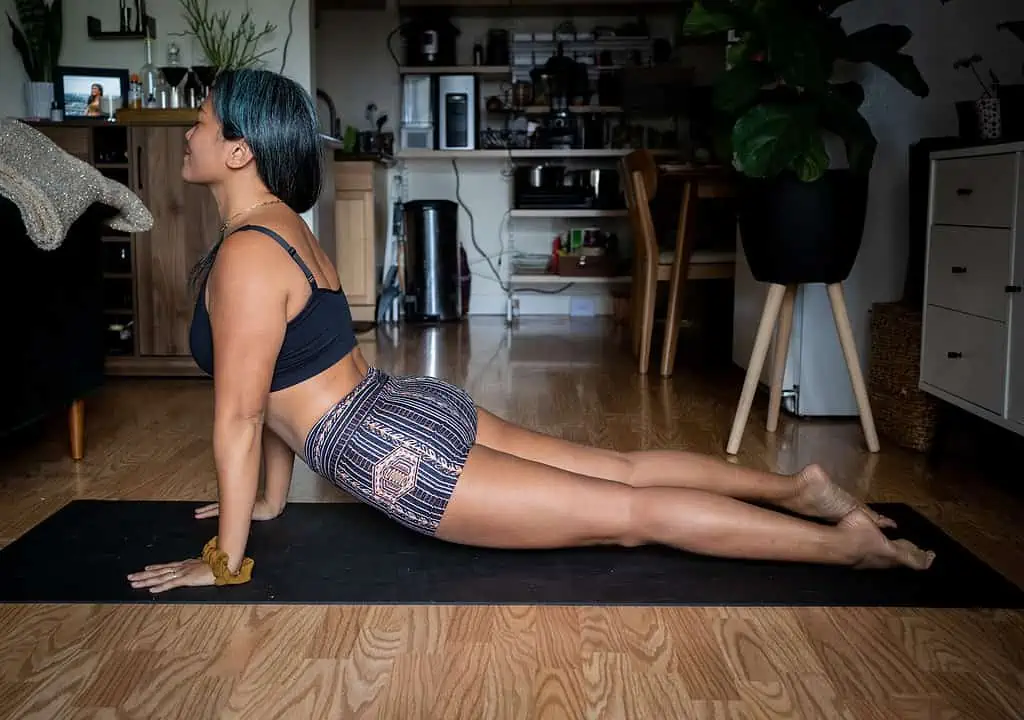
The upward-facing dog is a deeper variation of the cobra pose, practiced in sun salutations A and B. It stretches the torso and chest while strengthening the spine, wrists, and arms.
- From a prone position with your feet untucked and hands alongside the shoulders (not under them), engage your glutes and back and press into your hands.
- Extend your arms fully and lift your thighs and knees off the ground while keeping your hips low.
- Draw your shoulders away from your ears and focus on pressing your chest forward.
Sphinx Pose
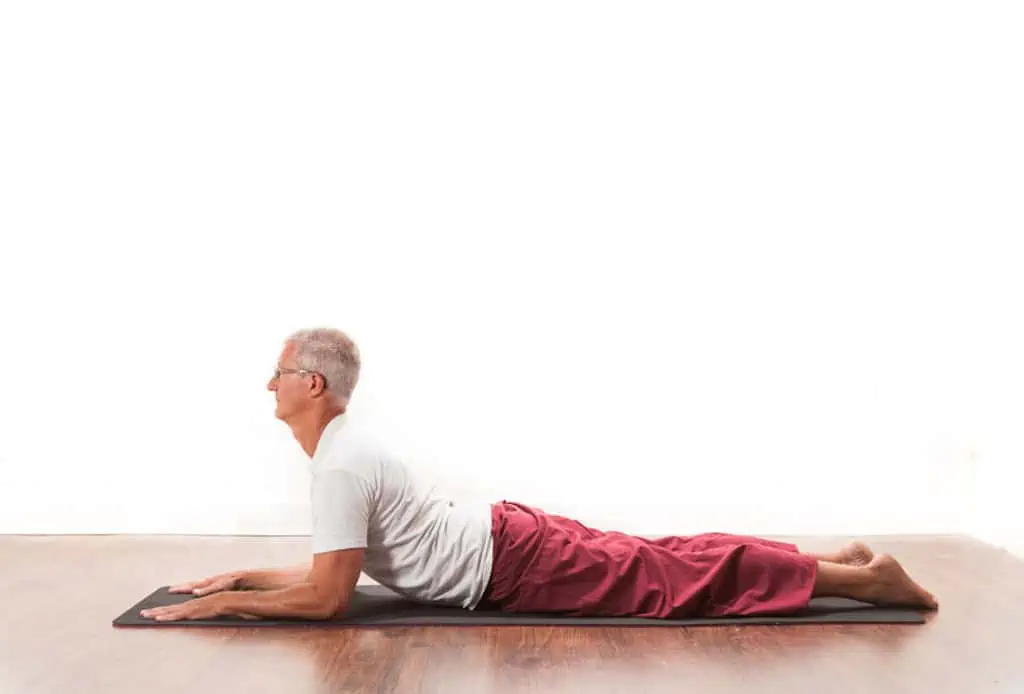
The sphinx pose is a gentler variation of the previous two heart-opening yoga poses. It is often practiced in yin or restorative yoga and is held longer (around one minute). Along with stretching the chest and opening the lungs, it firms the buttocks and stimulates the digestive organs.
From prone, lift your chest and press your forearms into the mat. The forearms should align with the shoulders, and elbows directly below the shoulder blades. As you press into the forearms and hips, draw your chest forward and look straight ahead. Ensure your shoulders are not hunching up to your ears.
Bow Pose
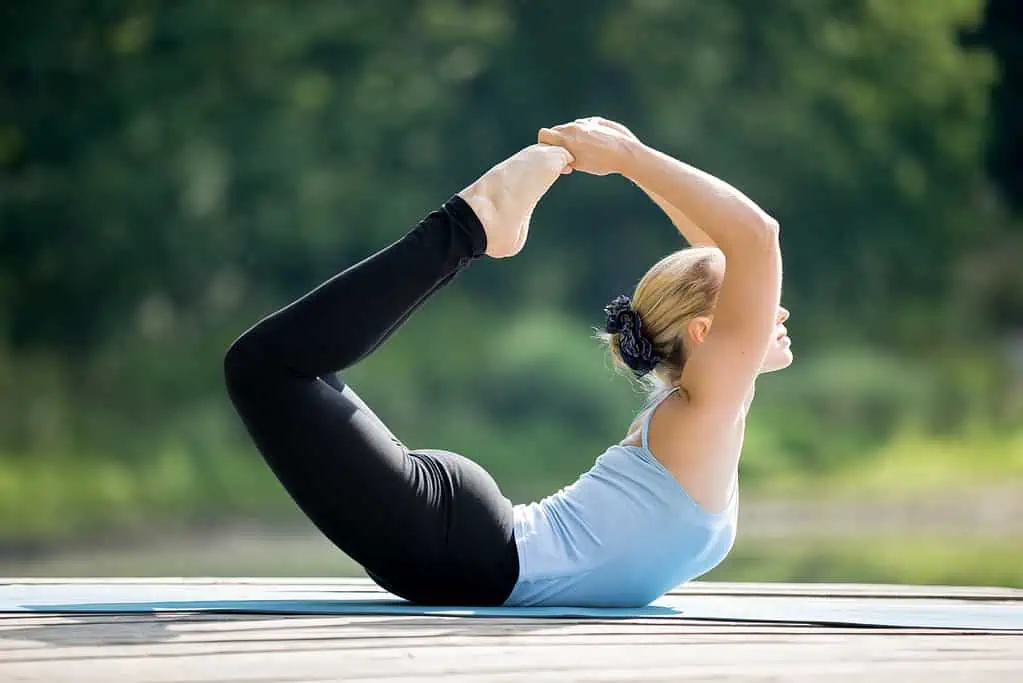
Bow pose is the most advanced heart opener out of all the prone backbends. Along with the usual back-bending benefits, the bow pose opens the shoulders, stretches the quads, conditions the arms and legs, and tones the neck muscles.
- From prone, bend your knees and reach behind with your arms to grab your feet from the outside (fingers pointing to the inside of the foot).
- Draw your shoulders back and press your hips down as you kick your feet into your hands and lift your knees.
- Take a deep breath, then try to find more lift in the chest by kicking more into the hands.
Camel Pose
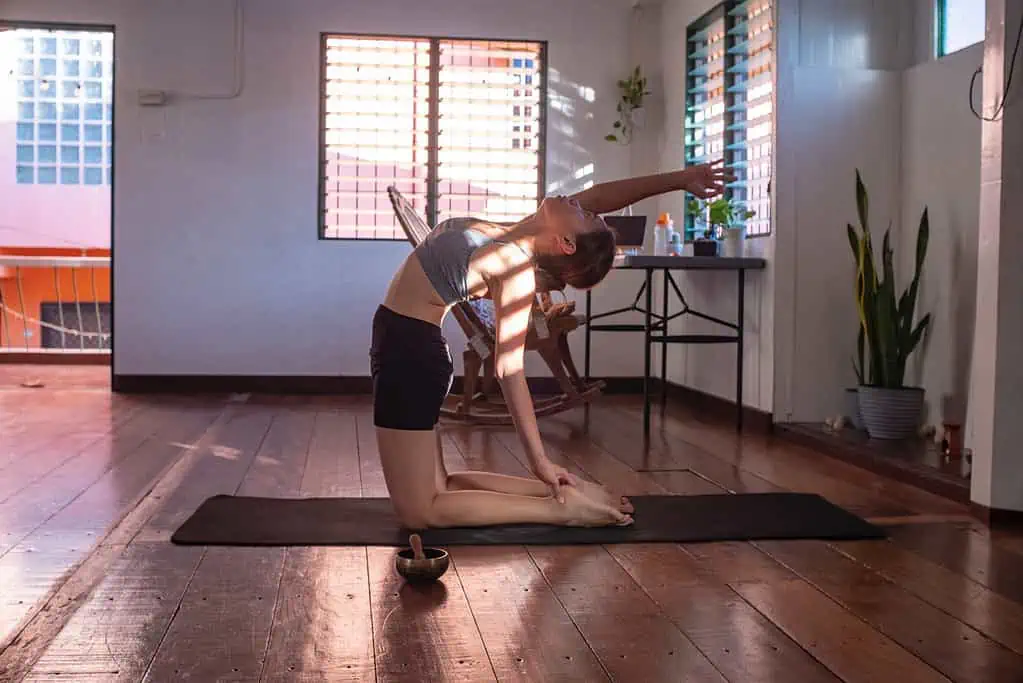
Camel pose is a deep, heart-opening posture that energizes the body, stimulates the thyroid gland, and helps release tension in the cervical spine. In addition, it strengthens the muscles in the chest, abdomen, and quads while toning the glutes and hamstrings.
- From a kneeling position with the hips lifted, bring your hands to your lower back with the fingers pointing down.
- Draw your elbows together behind you to pull the shoulder blades together. Engage your quads and glutes as you lean back, curving your spine from the bottom to the top.
- For many people, this is already an intense stretch. However, if you can go deeper, move your hands to your heels (toes tucked) and drop your head back to open the throat.
- Breathe deeply into the heart space and keep pressing the hips forward as you hold for 5 breaths.
- To come out, bring your hands back onto your back and roll the spine up one vertebra at a time.
Wild Thing
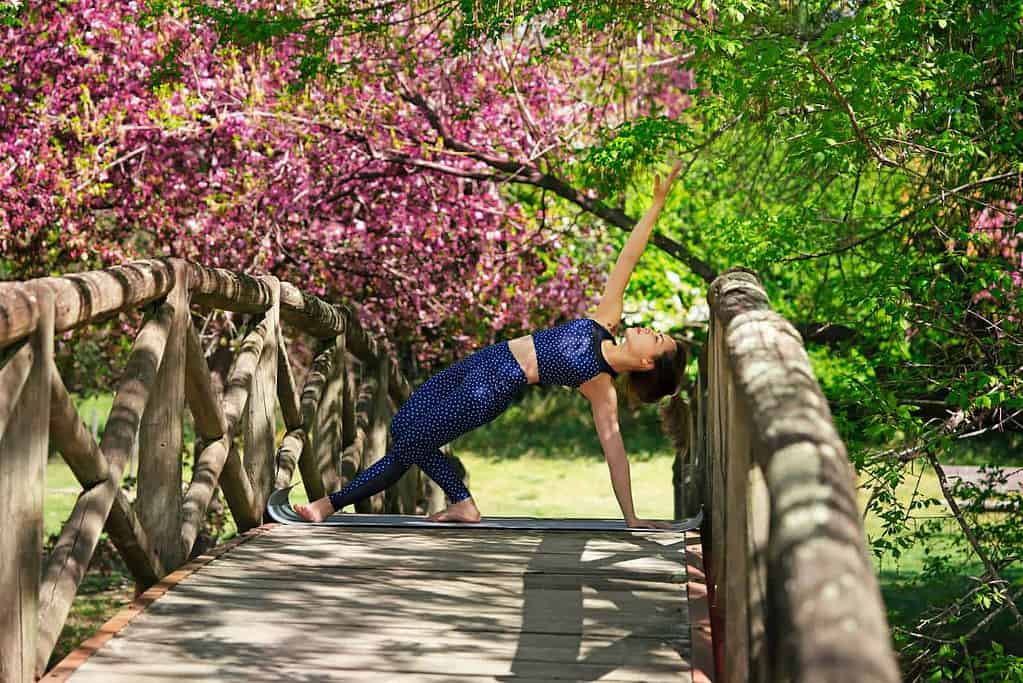
This fun, energizing back bend is a popular posture in vinyasa flow classes and has similar benefits to wheel pose but can be more accessible for many yogis. Its benefits include improving blood circulation and strengthening the shoulders and upper back.
- Extend your right leg up to the sky from a downward-facing dog.
- Bend the knee of the lifted leg, bringing the foot to the buttocks, to open the hip.
- Slowly lower the leg behind you and drop the right foot to the floor as you lift your right arm.
- Press your hips and chest up as you reach your lifted arm toward the front of your mat. The right knee should be bent, and the left leg should be straight. Gaze up to keep the neck and chest open.
Dancer’s Pose
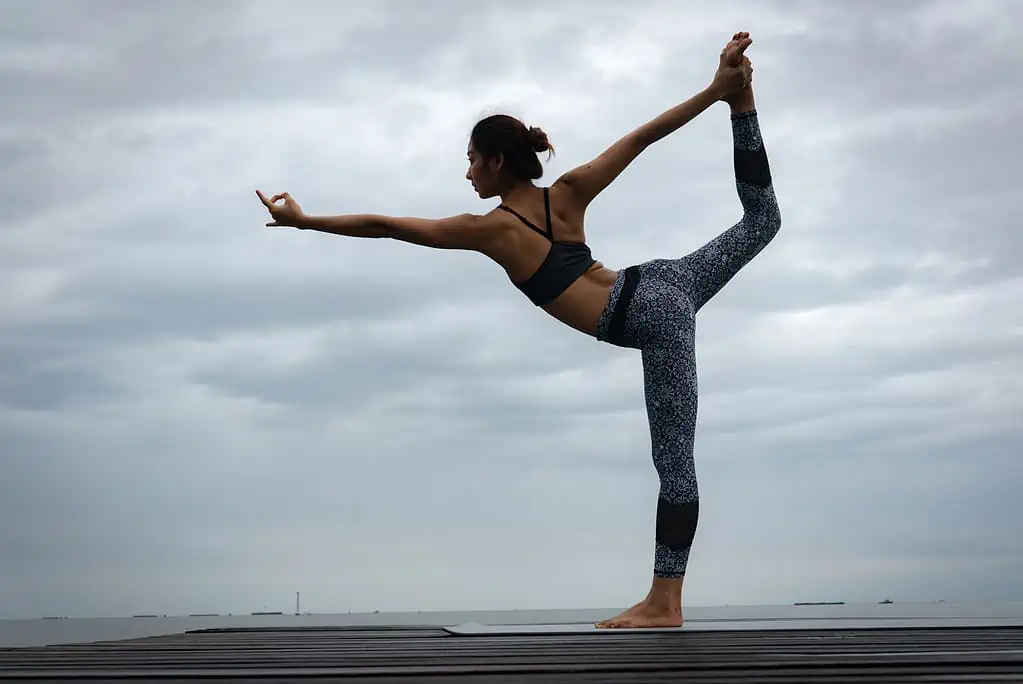
This elegant-looking standing balance has many benefits, including strengthening the legs, ankles, and knees and stretching the quads. It also opens various body parts, including the chest, shoulders, abdomen, and hip flexors.
- From standing with your feet together, shift your weight into your right leg.
- Bend your left knee as you grab the foot with your left hand.
- Extend your right arm up and forward, bringing the hand into the Gyan mudra.
- Kick your left foot into your hand as you reach your upper body forward.
- Arch the spine to open the chest and kick the left leg back further. Breathe into the heart center as you hold for 5 breaths.
Bridge Pose
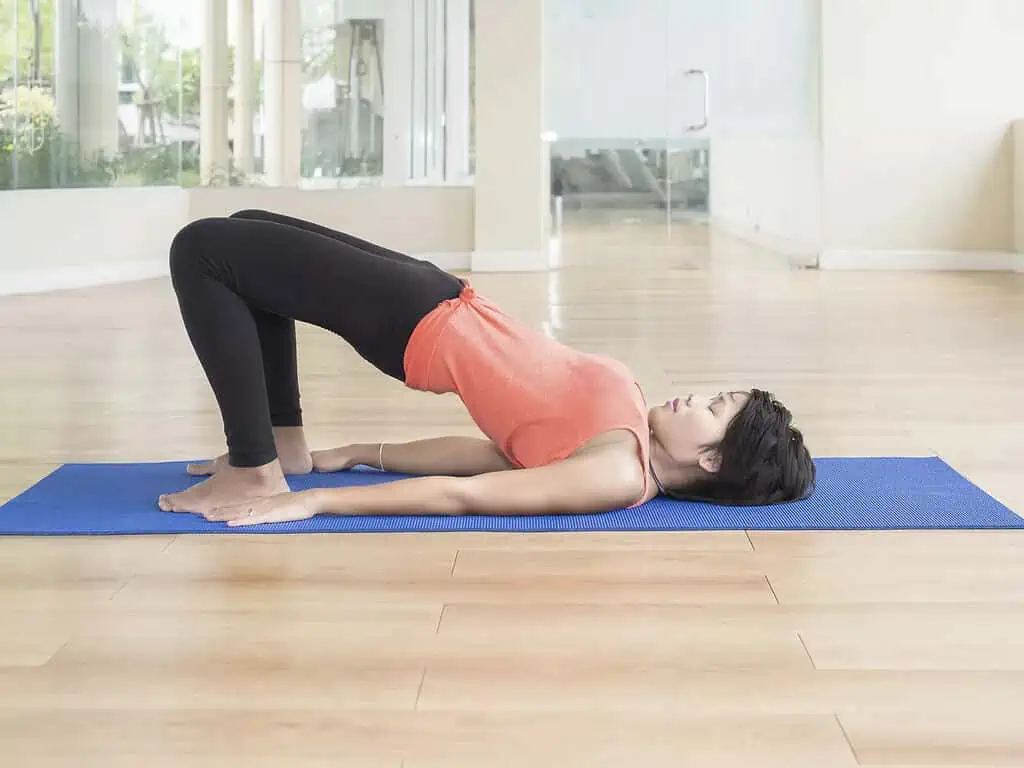
Bridge pose (Setu Bandha Sarvangasana) is a popular supine backbend that can be practiced actively (like in Hatha yoga) or passively with the support of props (like in restorative yoga). The bridge pose is hugely strengthening for the back and thigh muscles. It also improves the respiratory system and calms the mind.
- Lay on your back with your knees bent and the soles of your feet on the ground. Walk your feet in towards you so you can touch the heels.
- With the feet hip-distance apart, press them firmly into the ground to lift the hips.
- Clasp your hands underneath you and walk the shoulder blades closer together.
- Press the upper arms into the ground to lift the hips higher. Keep both feet on the ground and hug the inner thighs together, engaging the quads as you hold.
Wheel Pose
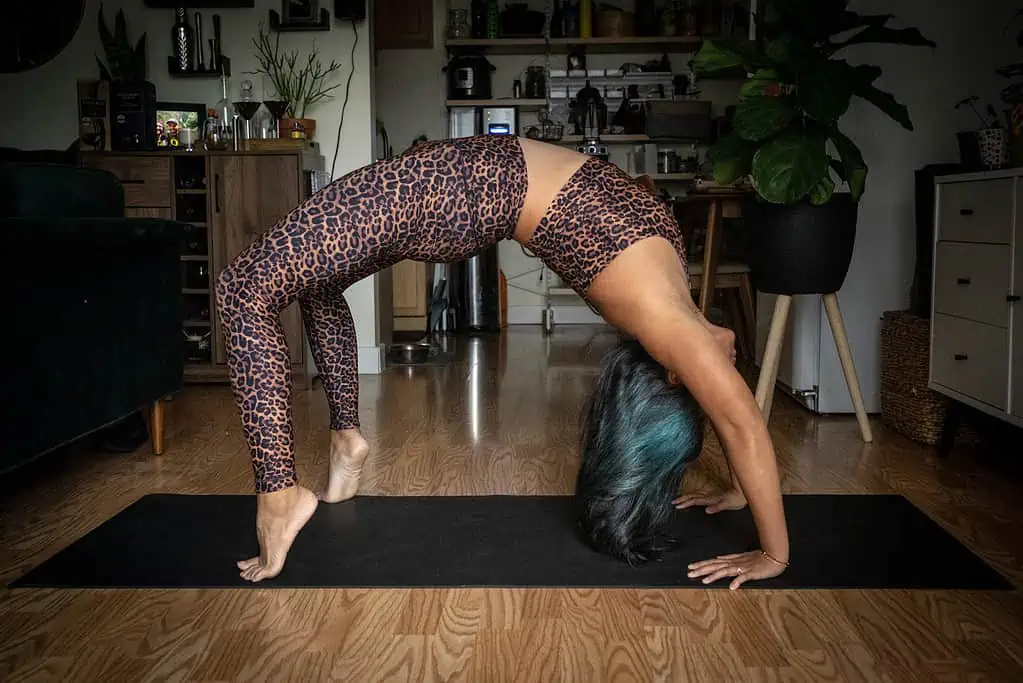
The wheel pose opens and stretches the upper body, hips, and quads. It is a more advanced version of the bridge pose with many therapeutic benefits, such as improving blood glucose levels and adrenal function. It is also one of the best poses for improving spinal flexibility.
- Start in a reclined position with the knees bent and the soles of the feet on the ground.
- Bring your hands next to your ears, with the fingertips pointing towards the shoulders and elbows directly up.
- Press your feet down and engage your quads to lift your hips.
- Next, press into your hands to lift your chest and head, allowing your head to drop back.
- Extend your arms and legs as you push your hips forward and up. Imagine pressing your hips in one direction and your chest in the other.
- Keep your thigh and lower back firmly engaged as you hold for 5 breaths. Then release first the thoracic spine and then the lumber region.
Fish Pose
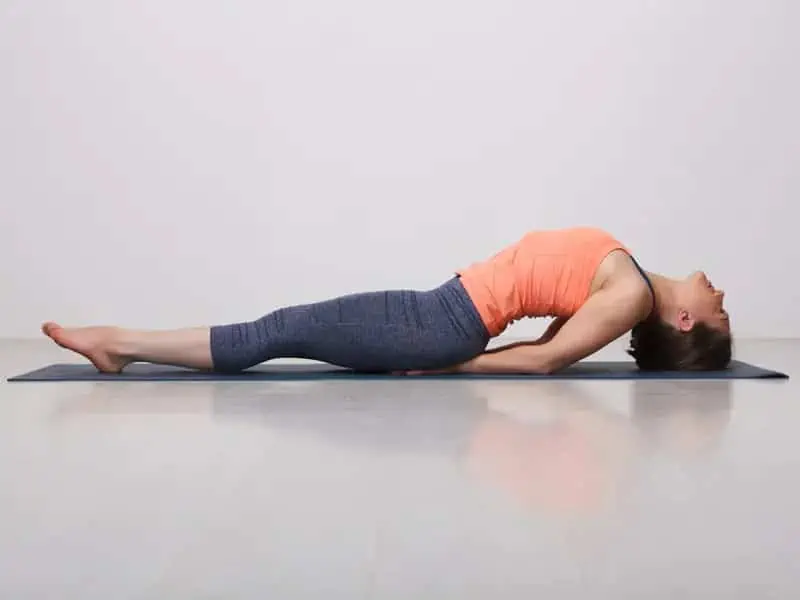
Fish pose is usually the last heart-opening posture in yoga classes. It is always practiced after a shoulder stand or plow pose to reopen and stretch the chest and throat. It extends the entire front body, stimulating the organs and relieving neck, throat, and shoulder tension.
- From a reclined position with the legs straight, bring your hands under your buttocks with the palms facing down.
- Press into your forearms to lift the chest and tilt the head back. Elbows should be bent and close together.
- Point your toes away from you and breathe into the rib cage for five breaths.
How To Stay Safe when Practicing Heart-Opening Yoga Poses
While backbends can have many tremendous benefits, they can do more harm than good if not practiced with caution. Here are three pointers on how to do backbends safely.
Warm Up Your Spine First
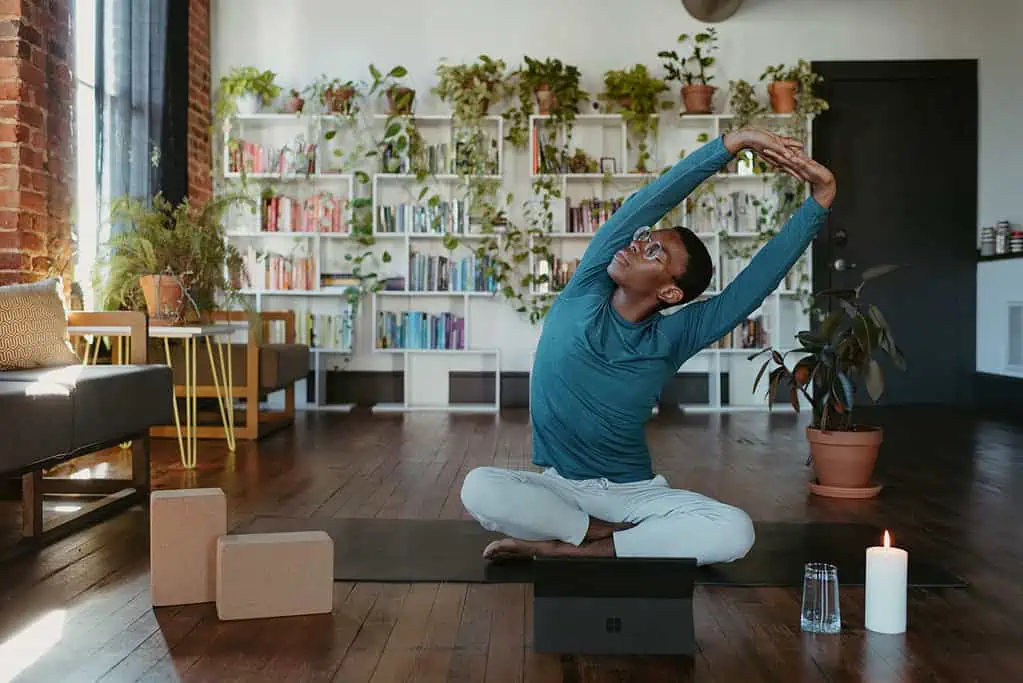
Back injuries are one of the most common in yoga and usually occur if the spine, back, and chest have not been warmed up thoroughly before practicing heart-opening asanas.
Warm up by doing all four types of spinal movement: flexion (bending forward), extension (bending backward), lateral flexion (side bending), and rotation (twisting). The following three yoga poses cover all of these.
- Cat/cow pose
- Seated side bends
- Seated twists
Sun salutations are another excellent way to warm up the spine, as they involve lots of gentle back bending and forward folding and build internal heat. Thus, I recommend doing a few rounds before moving into any deep backbend.
If you plan to practice a deeper backbend like the wheel or camel pose, you must also do preparatory postures to open the front body, hips, and shoulders. Therefore, these poses should be practiced toward the end of the session, when these areas are more open.
Move With Your Breath
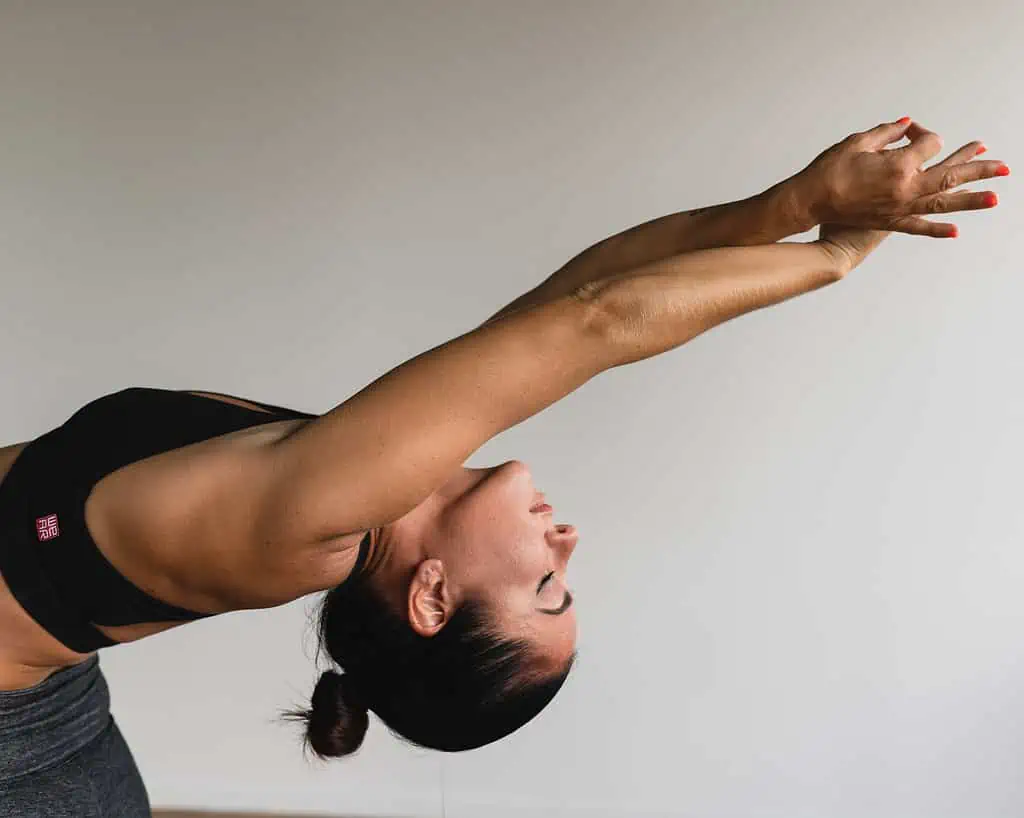
Deep breathing helps our muscles relax and our bodies open up, so connecting to our breath is vital when doing backbends.
Generally, you should move into a back bend on the inhale. You can then hold for the exhale before going deeper on the next in-breath. Once you reach your maximum, take a few deep breaths as you maintain the position, and then release it slowly on an exhale.
Practice Counter Poses
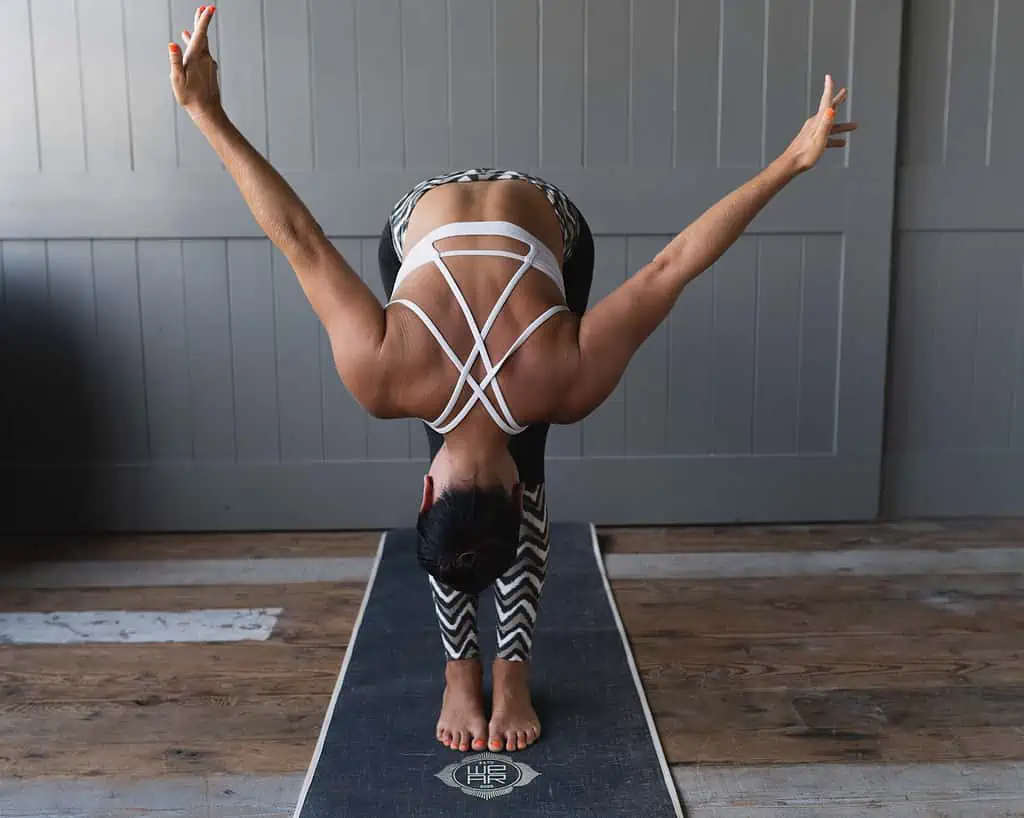
Counter poses are essential after any challenging or strenuous asana, but even more so with back-bending postures.
When we come into a back bend, we practice spinal extension, so we need to counterbalance this with spinal flexion, which we do in forward folds.
Thus, if you are doing a yoga practice with many heart openers, include plenty of forward folds between the back bends and at the end of the session.
The child’s pose is a go-to counter pose for any heart opener, but standing and seated forward folds work just as well. Moreover, if you are doing reclined backbends like a bridge or wheel, hug your knees to your chest in Apanasana (the wind-relieving pose) for at least a few breaths after to realign the spine.
Twists also help to neutralize the spine after a heart-opening practice, so include a couple of seated and supine twists towards the end of your session.
The Emotional and Physical Connection of Heart Openers
Emotional Connection
Heart-opening poses go beyond stretching; they create a space around the heart, which can have a profound emotional impact. Consider this; during times of stress or sadness, we tend to close off by hunching over. In contrast, heart openers encourage us to expand and open up potentially releasing pent-up emotions. It’s akin to letting air into a room—refreshing yet sometimes overwhelming all parts of the journey.
Physical Relationship
From a perspective, these poses do wonders for posture improvement by strengthening muscles around the spine and shoulders. This enhanced strength can lead to increased confidence levels. Moreover, there exists a connection between heart opening poses and breathing—the expansion of the chest creates room for lung capacity ultimately enhancing our function. Better breathing equals oxygen flow—an element, for overall well-being.
Increased oxygen levels lead to energy levels. Improved mental clarity.
Therefore engaging in heart-opening yoga poses doesn’t just benefit our bodies; it also positively impacts our emotional well-being. The interconnectedness of the body, mind, and emotions is an aspect of yoga. It goes beyond postures to influence us holistically.
The Importance of Breathing in Heart-Opening Yoga
Exploring the Wonders of Ujjayi Breathing
Let’s delve into the realm of Ujjayi breath; it truly works wonders. My initial experience incorporating it into backbends was remarkably impactful – a contrast that heightened my flexibility and openness. It’s as though your body intuitively responds to the rhythm of your breath.
Heart-opening poses can evoke sensations. Stir emotions within us. This is where conscious breathing plays a role. Deeply inhaling and exhaling through these postures serves as a reassurance to our bodies signaling that it’s safe to release tension and surrender. This practice has personally aided me. I believe it holds benefits for others as well.
Throughout my journey prioritizing breathing has yielded profound effects. It transcends alignment; instead, it focuses on cultivating an inner sensation while practicing yoga postures. The breath acts as a catalyst for transforming this experience – a potent tool deserving wider recognition, among practitioners.
Final Thoughts On Heart-Opening Yoga Postures
Backbends are invigorating, strengthening, and healing, but they should always be practiced with care. Whether you want to boost your energy, cultivate self-love, or improve your flexibility, adding heart openers to your yoga sessions will enhance your practice and daily life.
Pop quiz! 🧘🤔
Practicing heart-opening yoga poses can improve digestion.
The heart chakra is located in the lower abdomen.
Backbends should be avoided in a yoga practice to prevent injury.


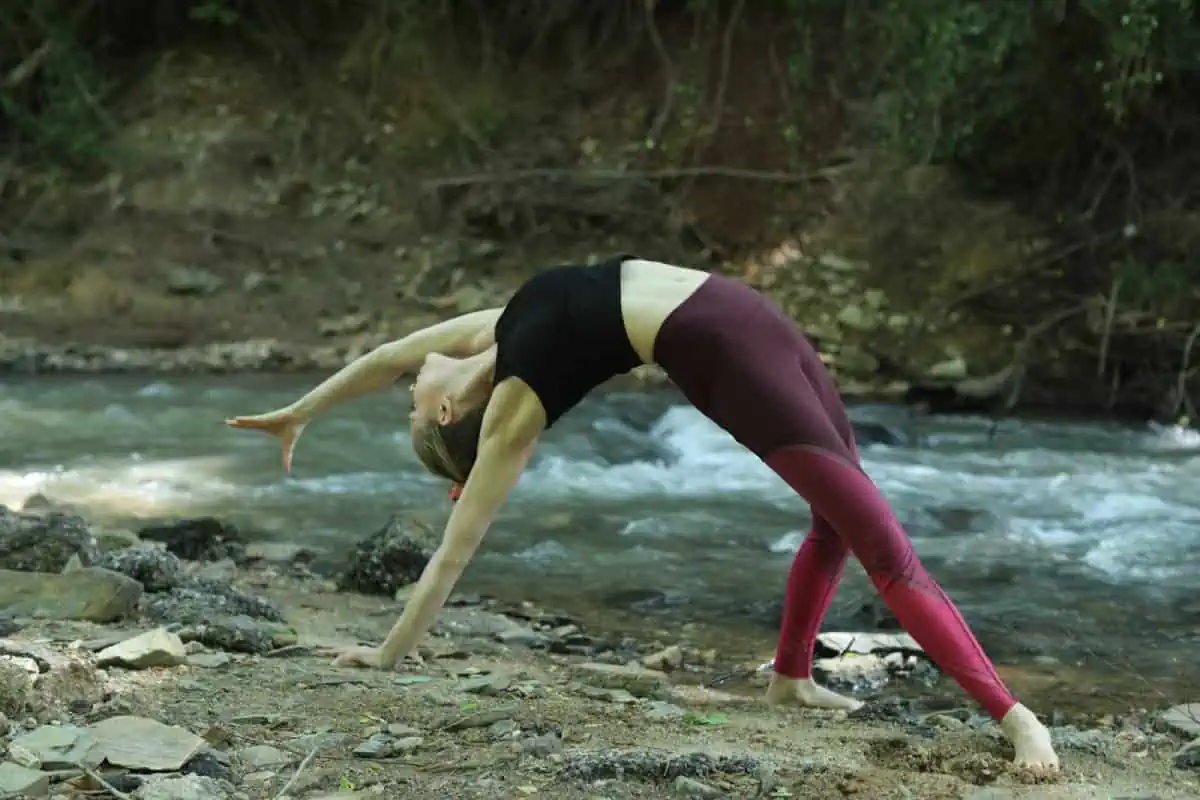





Your Blog is outstanding and amazing. Thanks for sharing.